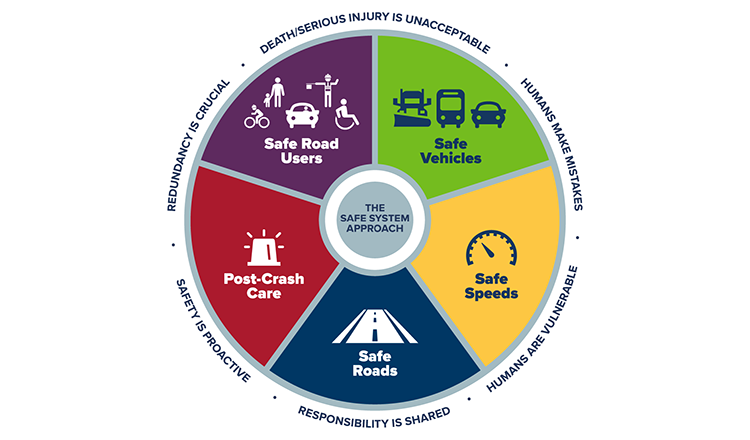MnDOT Safe System Approach Implementation Plan

MnDOT Safe System Approach Implementation Plan
Road Safety Planning Expertise To Integrate the SSA Framework Into Agency Processes
- Research into proven strategies in SSA implementation
- Consultations with leading global agencies in road safety planning and design
- Internal MnDOT advisory meetings to review and revise list of SSA strategies
- Comprehensive plan to complement existing agency road safety initiatives
The Minnesota Department of Transportation (MnDOT) and its state transportation partners have long been at the forefront of prioritizing innovative road safety solutions, with increased safety engineering efforts and initiatives. But after years of improvement, traffic fatalities and serious injuries increased on Minnesota’s roads from 2020 through 2024. As a result, MnDOT sought enhanced measures to reverse the trend of increased deaths and injuries.
Aligning with guidance in the state’s 2022 Statewide Multimodal Transportation Plan to prioritize the adoption of the Safe System Approach (SSA), MnDOT committed to creating an SSA Implementation Plan. The SSA focuses on reducing road fatalities and serious injuries by proactively considering safety, providing redundancy, and accommodating human mistakes and fragility of the human body. MnDOT hired our team — with extensive experience in safety planning both nationally and in Minnesota — to develop a plan to apply and integrate the SSA into their programming and project delivery processes.

One of our first steps in managing the project was researching successful examples of SSA implementation by agencies, tapping into our global team of traffic safety professionals with historical SSA implementation experience. We also reviewed MnDOT processes and led internal engagement sessions to identify ways to best institutionalize the SSA into practice.
Balancing Safety Initiatives
In the beginning, our project team required an understanding of MnDOT’s programming and project delivery policies and procedures. Early work sessions were formed with DOT leaders of functional groups throughout the agency. Their insight was key to overcoming an early challenge of balancing systemic changes required for SSA integration with MnDOT’s existing safety programs. It was discovered that any implementation plan would need to leverage those existing programs, with the SSA serving as the overarching framework to build upon and enhance existing safety work.
Along with insight into the challenges and priorities of these groups, the meetings generated support for the plan’s strategies and actions among those involved in their development and future implementation.
At the same time, we navigated unfamiliar territory. While the Federal Highway Administration (FHWA) and the U.S. Department of Transportation adopted and recommended the SSA, there were few resources on how transportation agencies should implement the approach. To bridge this gap, we met with the FHWA to discuss their vision for SSA implementation at the state level. We then identified and interviewed state DOTs with their own approaches to integrating the SSA framework into their operations, including California, Florida and Massachusetts. In Queensland, Australia, SSA-aligned guidance has been standard practice in the delivery process for the Department of Transport and Main Roads (TMR) for decades. We interviewed TMR to learn from an agency further along in its implementation efforts. We relied on the expertise of local HDR professionals in Australia with firsthand experience delivering road projects under these requirements. Their in-house knowledge provided unique insight but also a direct connection with the Queensland TMR.
Through comprehensive research, policy reviews and interviews with these agencies, we identified five key takeaways for MnDOT to translate the SSA principles into action:
- Assure strong leadership support
- Provide training with actionable takeaways
- Prioritize engagement opportunities
- Identify the easy wins
- Consider a public health perspective
An Inclusive Approach
Building on lessons learned and best practices gathered from initial research and interviews, our team created a draft list of strategies and actions for advancing SSA integration within MnDOT while maintaining existing agency procedures. This draft was reviewed by key DOT leaders who shaped a preliminary set of targeted strategies, including:
- Institutionalizing the SSA as MnDOT’s approach to traffic safety
- Integrating the SSA into MnDOT’s standard operating procedure and practices
- Identifying SSA implementation leaders throughout MnDOT
Seeking further agencywide input to shape strategies and actions, we led five advisory committee meetings with representatives from different disciplines across MnDOT. A key concern raised during these sessions was how to sustain long-term momentum for SSA while balancing other agency priorities. In response, an immediate priority action for MnDOT to adopt a change management model to guide SSA implementation was drafted to be added to the final plan. This step aims to support the cultural change needed for successful, agencywide adoption of SSA over time.
Once a list of strategies and actions was approved by the advisory committee, we drafted a final SSA Implementation Plan — outlining 26 actions for MnDOT to implement. It was adopted by the advisory committee and approved by MnDOT leadership in June 2025. Since adoption, MnDOT has begun implementing the highest priority actions, including development of an SSA resources webpage, initiation of a Speed Management Guide and early planning for an annual SSA for Practitioners course starting in Spring 2026.





